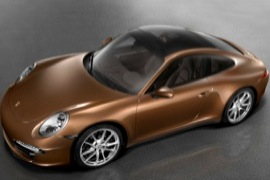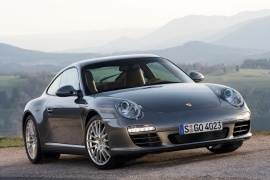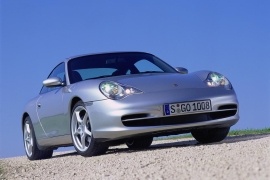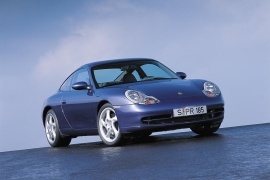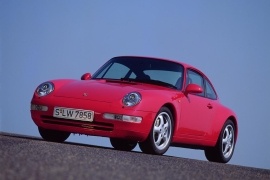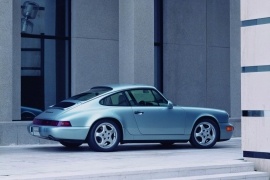PORSCHE 911 Carrera 4 Models/Series Timeline, Specifications & Photos
First production year: 1988
Engines: Gasoline
Body style: Coupé (two-door)
The Porsche's 911 roots started in 1963 and it continuously evolved ever since. It grew in size, engine, and power. It evolved from a sports car to a luxurious super-car. And the 2012 Carrera 4 Coupe was no exception.
The seventh generation of the 911 was launched in 2012 and it sits on a new platform, with a longer wheelbase and shorter overhangs. It also featured new headlights and taillights. The overall shape of the car didn't change that much since 1963 and that is one element why the 911 became an iconic car, same as the VW Beetle and the Land Rover Defender. The all-wheel-drive Carrera 4 was first introduced in 1988, on the Porsche 911 – 964 generation.
The round headlights with the white DRLs strips underneath, installed on the bumper were one key-feature of the 2012 Porsche 911. With its rounded greenhouse that was continued by the engine hood in the back, the seventh Porsche 911 kept its original shape. The all-wheel-drive version featured wider rear fenders by 22 mm (0.89”) on each side than the rear-wheel-drive version.
The interior was more about luxury than about performance. The new instrument cluster still had the center tachometer but on its left, there was a TFT display installed into the circle of the former analog gauge. The car-manufacturer offered a choice of steering wheels and seats to choose from, either for comfort, sports, or a balanced taste.
The 2012 Porsche Carrera 4 featured a 3.4-liter flat-six engine. It was mated as standard to a world's first seven-speed manual transmission. An automatic, PDK (dual-clutch) transmission was offered as an option. The Carrera 4 featured an all-wheel-drive torque distribution in the instrument cluster display.
In 2004, Porsche launched a new generation of its well-known Porsche 911. That generation was named 997 and it represented an important upgrade for the whole range, especially after the 2008 facelift.
After four years into production, a mid-life cycle refresh was ready for the market. Porsche had to improve its engines to make them cleaner and to respect the new pollution norms in Europe. It meant that it had to build its cars more fuel-efficient. As usual, the rest of the car suffered some minor changes too.
On the outside, the first difference was on the front bumper, where larger air-intakes were sculptured. The headlights were fitted with bi-xenon lamps while the running lights and taillights were fitted with LEDs as standard. The door mirrors were slightly redesigned. A new set of 18” light-alloy wheels was introduced for the Carrera 4. As usual, both versions S and 4S featured wider rear fenders.
Inside the car, on the center console, Porsche installed a new infotainment unit that featured a 6.5” touch-screen display. It featured an optional hard-drive navigation system and Bluetooth connectivity. An option for ventilated seats was added to the list.
The biggest change for the 2008 Carrera 4 was underneath the car. The Carrera 4 Cabriolet featured a 3.6-liter engine that cranked up 325 hp, 30 hp less than its 4S sibling, which had a 3.8-liter unit. A new, PDK 7-speed dual-clutch gearbox was installed on the car, replacing the older 6-speed automatic. For the braking system, the Carrera 4 was fitted with 330 mm (12.99”) discs in all corners.
The Porsche 911-997 generation was introduced in 2005 and it was more of an evolution rather than a revolution. But in terms of design, it was much better, even if that meant to return to the round headlights.
The 997 Carrera 4 was based on the same platform with its predecessor but enhanced. It had the same rear wide fenders as the Carrera 4S and the Carrera S and it offered an enhanced all-wheel-drive system, which transferred between 5 and 40% of the torque to the front wheels.
From the outside, the new round headlights were back, wiping off the tears from the Porsche fans. The turn-signals and the fog-lights were in the front bumper, above the apron. In the lower side, a wide center grille and two side-scoops with a horizontal slat were typical for this generation of the Porsche 911.
Inside, the 911 offered four seats but cramped in the rear. It offered four seating options: standard, electric, sport, and adaptive bucket-seats. For the instrument cluster, the Carrera 4 featured the classic five-dials layout, with a black background. The Porsche Communication Management was fitted as standard, but the navigation system was optional.
For the engine, the Carrera 4 offered a 3.6-liter engine that offered 325 hp. It was mated as standard with a 6-speed manual, while a 5-speed automatic with manual override (Tiptronic) was on the options list.
Porsche 911 Carrera 4 received a facelift along with the rest of the range in 2002. It brought a few options and a new pair of headlights. It was fitted with more powerful engines.
The 2001 Carrera 4 came on the market to attract even more customers. It was already established as a true sports-car and a great grand-tourer vehicle. Its rear-engine and all-wheel-drive configuration were highly appreciated by its customers, especially by those who had to drive on slippery surfaces.
From the outside, it was hard to notice the difference between the 1998 version and the facelifted model. The main difference was on the headlights. The 2002 model featured a clear lens for the entire lamp, while its predecessor featured a yellow lens for the turn-signals. The difference was even more striking for the vehicles sold in North America.
Inside, the main difference was the stereo, which received a digital AM/FM stereo and a CD-player. Other than that, it was the same four-seat sports car built for two adults for long journeys. In the 911 coupes, the rear seatbacks could have been folded down to create a flat cargo floor. It was a good daily driver vehicle and even more relaxing on long journeys.
The drivetrain received a new 3.6-liter engine and it gained 20 hp more than the non-facelifted version. It was fitted with a standard 6-speed manual. The 5-speed automatic (Tiptronic) gearbox with manual override to change gears was on the options list. Due to its all-wheel-drive system, it could cope better with the bad weather than most of the sports-cars from that era.
Designed as a grand tourer, the Porsche Carrera was the base version for the 911 range in 1998. It good as a daily driver and due to the all-wheel-drive system, it was an all-weather sports-car.
The 996 Porsche was unveiled in 1997. The Carrera was the quickest naturally aspirated Porsche 911 from its times, apart from the GT3 versions, which were track-focused vehicles. The main advantage of the 911 was that it was a true, daily-driver, sports-car. It was the first water-cooled 911.
From the outside, the big headlights were oddly shaped and that brought a lot of criticism from Porsche fans around the world. The main difference between the 1998 Carrera and the facelifted version was that on this model, the turn-signals were placed at the bottom of the headlights. From the side, the flush bodywork, without any enlargements for the wheel-arches, offered a clean look.
Inside, the car was fitted as standard with a stereo and air-conditioning. It was the first Porsche 911 with a center stack. Since it was the base model in the stable, it didn't feature too many luxury items, but those were on the options list. The standard seats could have been upgraded to power-adjustable leather seats. Another pair of seats were installed in the back, but mainly for tax and insurance purposes. They were tiny even for a small child.
Under the engine lid, there was a newly-developed flat-six engine that offered 300 hp. It was mated as standard with a six-speed manual. A 5-speed automatic (Tiptronic) with manual override to shift gears was on the options list. The Carrera 4 was rear-wheel-drive.
The Porsche 911 – 993 marked the end of the air-cooled engines for the Germans sports-car manufacturer. Due to new rules for pollution norms, they had to switch to water-cooled engines.
For some, the 993 generation was the last true 911. Even though after that the car-maker built faster cars, the 993 still had that specific Porsche sound. It was the mix between the old and new school, with enough comfort for a daily-driver car, and good performance.
The Carrera 4 was the base all-wheel-drive version of the naturally aspirated 911. It featured two round headlights, in the tradition of the Porsche brand. The flat and low trunk-lid in the front was lower than the fenders. The windshield was not very raked and the sloped back toward the end of the car made a curved line along with the engine lid. A rear spoiler was installed and it was automatically extended depending on the car's speed, or via a button installed in front of the gear-stick.
The interior featured sport-bucket seats in the front and two small seats in the back. The instrument cluster featured five dials, with the tachometer in the middle and a clock on the right side. The climate controls and the stereo were mounted in line with the steering column.
The engine was a completely reworked flat-six, with a 3.6-liter displacement. It was offered in two versions of power, depending on the market and manufacturing year. A newly-developed suspension system resolved the lift-off oversteer problem form the previous generation. The all-wheel-drive system was improved over the 964 Carrera 4. It was offered with a 6-speed manual or with the Tiptronic (automatic transmission) with manual override for gear changes.
The 1988 Carrera 4 took its shape from its predecessor, but that was one of the few things that took. Most of its parts were completely new or improved. Adding an all-wheel-drive system was a plus.
By 1988, Porsche was already known as a daily-driver supercar or, at least, sports-car. But with the winters that were back then, a rear-wheel-drive vehicle was difficult to drive in winter conditions. The rear engine added weight so the car was not so eager to slip. But when it did, it went all the way and it was hard to control it without the aid of an ESP or a traction-control system. This is why Porsche offered the all-wheel-drive 911. A true, all-weather, Carrera.
Its curvy shape, with flat and lower than fenders trunk lid, which was in the front, and a sloped-back in an arch-like greenhouse, were the definition of the 911 shape. The big round headlights and the swept rear-end were specific for the German sports car.
Inside, the owners of the previous generation noticed more similarities with the old generation. The main differences are for the safety systems. The 964 was fitted as standard with dual airbags, for the driver and front passenger. In the back, there were two small (very small) seats. The five dials for the instrument cluster featured a black background.
The magic of the Carrera 4 was in its technological department. A new, 3.6-liter engine with twin-spark plugs, offered 250 hp. The all-wheel-drive system with self-locking differentials allowed the car to start better and to get 5.9 seconds from 0 to 100 kph (0-62 mph). The new struts suspension instead of the older torsion bar system helped the car to get higher cornering speeds.
